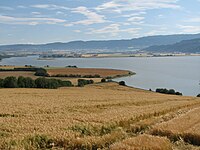Norway comprises the western part of Scandinavia in Northern Europe. The rugged coastline, broken by huge fjords and thousands of islands, stretches 25,000 kilometres (16,000 mi) and 83,000 kilometres (52,000 mi) including fjords and islands. Norway shares a 1,619-kilometre (1,006 mi) land border with Sweden, 727 kilometres (452 mi) with Finland and 196 kilometres (122 mi) with Russia at the east. To the north, west and south, Norway is bordered by the Barents Sea, the Norwegian Sea, the North Sea and Skagerrak.
 |
| Norwegian lowland landscape near the Gaulosen branch of Trondheimsfjord. |
 |
| Reine in Lofoten, Northern Norway. |
At 385,252 square kilometres (148,747 sq mi) (including Svalbard and Jan Mayen), (and 323,802 square kilometres (125,021 sq mi) without) much of the country is dominated by mountainous or high terrain, with a great variety of natural features caused by prehistoric glaciers and varied topography. The most noticeable of these are the fjords: deep grooves cut into the land flooded by the sea following the end of the Ice Age. The longest is Sognefjorden at 204 kilometres (127 mi). Sognefjorden is the world's second deepest fjord, and the world's longest. Hornindalsvatnet is the deepest lake in all Europe. Frozen ground all year can be found in the higher mountain areas and in the interior of Finnmark county. Numerous glaciers are found in Norway.
Norway lies between latitudes 57° and 81° N, and longitudes 4° and 32° E.
The land is mostly made of hard granite and gneiss rock, but slate, sandstone and limestone are also common, and the lowest elevations contain marine deposits. Because of the Gulf Stream and prevailing westerlies, Norway experiences higher temperatures and more precipitation than expected at such northern latitudes, especially along the coast. The mainland experiences four distinct seasons, with colder winters and less precipitation inland. The northernmost part has a mostly maritime Subarctic climate, while Svalbard has an Arctic tundra climate.
Because of the large latitudinal range of the country and the varied topography and climate, Norway has a larger number of different habitats than almost any other European country. There are approximately 60,000 species in Norway and adjacent waters (excluding bacteria and virus). The Norwegian Shelf large marine ecosystem is considered highly productive.
Climate of Norway
The southern and western parts of Norway experience more precipitation and have milder winters than the southeastern part. The lowlands around Oslo have the warmest and sunniest summers but also cold weather and snow in wintertime (especially inland).
Because of Norway's high latitude, there are large seasonal variations in daylight. From late May to late July, the sun never completely descends beneath the horizon in areas north of the Arctic Circle (hence Norway's description as the "Land of the Midnight Sun"), and the rest of the country experiences up to 20 hours of daylight per day. Conversely, from late November to late January, the sun never rises above the horizon in the north, and daylight hours are very short in the rest of the country.
Biodiversity of Norway
The total number of species include 16,000 species of insects (probably 4,000 more species yet to be described), 20,000 species of algae, 1,800 species of lichen, 1,050 species of mosses, 2,800 species of vascular plants, up to 7,000 species of fungi, 450 species of birds (250 species nesting in Norway), 90 species of mammals, 45 fresh-water species of fish, 150 salt-water species of fish, 1,000 species of fresh-water invertebrates and 3,500 species of salt-water inver About 40,000 of these species have been described by science. The red list of 2006 encompasses 3,886 species.
Seventeen species are listed mainly because they are endangered on a global scale, such as the European Beaver, even if the population in Norway is not seen as endangered. There are 430 species of fungi on the red list, many of these are closely associated with the small remaining areas of old-growth forests.[47] There are also 90 species of birds on the list and 25 species of mammals. 1,988 current species are listed as endangered or vulnerable as of 2006; of these are 939 listed as vulnerable (VU), 734 species are listed as endangered (EN), and 285 species are listed as critically endangered (CR) in Norway, among these are the gray wolf, the arctic fox (healthy population on Svalbard) and the pool frog.
The largest predator in Norwegian waters is the sperm whale, and the largest fish is the basking shark. The largest predator on land is the polar bear, while the brown bear is the largest predator on the Norwegian mainland, where the common moose (also known as the "European Elk") is the largest animal.
Environment of Norway
Throughout Norway, one will find stunning and dramatic scenery and landscape. The west coast of southern Norway and the coast of northern Norway present some of the most visually impressive coastal sceneries in the world. National Geographic has listed the Norwegian fjords as the world's top tourist attraction. The 2008 Environmental Performance Index put Norway in second place, after Switzerland, based on the environmental performance of the country's policies






 Posted in:
Posted in: 



